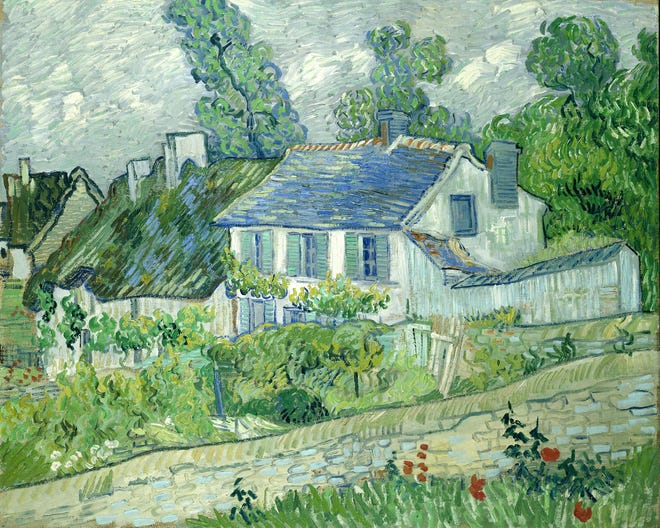The Van Gogh exhibit at the Columbus Museum is an experience not to be missed
[ad_1]
The Columbus Museum of Art pays homage to Vincent Van Gogh and his contemporaries in a spectacular, thoughtful and unmissable exhibition.
“Through Vincent’s Eyes: Van Gogh and His Sources†celebrates the tortured Post-Impressionist with 17 of his iconic works, interspersed with over 100 paintings, prints and sculptures by artists who influenced and admired Van Gogh.
The beautifully installed exhibition places van Gogh’s works against a dark blue background, surrounded on white walls by meaningful works created by Van Gogh’s contemporaries.
Thus, it is possible to take a 15-minute guided tour of the “Louvre” to find and inspect only the works of Van Gogh. But viewers would be doing themselves a disservice to take this route; throughout the exhibition there are artistic gems like Edgar Degas, Paul Gauguin, Edouard Manet, Claude Monet, Camille Pissarro and Henri from Toulouse-Lautrec, to only cite a few.
Following:Visual arts: Bruce Robinson’s art reflects the layers of meaning behind his passion
In addition, the panels accompanying all the works provide relevant and entertaining information.
There are many quotes from van Gogh himself, drawn largely from his correspondence with his brother and supporter, Theo, which tell what the artist thought of his fellow painters and how they influenced his work.

For example, when you enter the exhibition, one of the first paintings to strike your attention is “Roses (1890) by van Gogh), a beautiful oil belonging to the National Gallery of Art in Washington DC. Originally painted pink, the roses have faded so that in today’s painting they are white. On one side of the “Roses” hang the “Summer Chrysanthemums” by Henri Fantin-Latour (1887) and on the other, the “Peonies” by Manet (1864-1865). The sign includes the following quote from van Gogh:
“Do you remember that one day at the Hotel Drouot we saw a rather extraordinary Manet, big pink peonies and their green leaves on a light background?” As much in harmony and as much a flower as anything you love, and yet painted in solid and thick impasto…. This is what I would call the simplicity of the technique.
This kind of placement of works and information is a great experience for the viewer – appreciating the artistry of van Gogh and his peers in a presentation rich in context.

Of course, there are some notable works by Van Gogh – not the iconic “Sunflowers†​​or “Starry Nightâ€; these are not part of this exhibition – but magnificent still lifes, landscapes and portraits, including “Maisons à Auvers†and “Les Vessenots à Auvers†(1890), “diligence de Tarascon†(1888), “Sous- wood with two characters â€(1890), the lithograph“ Eaters of potatoes â€(1885) and“ Portrait of Dr Gachet â€(1890), the only etching by van Gogh which captures the doctor who treated him in the last years of his life.
Van Gogh’s love and appreciation for Japanese art – he collects woodblock prints – is reflected in the inclusion of fine works by Ando Hiroshige (“Sudden
Evening Shower at Ohashi Bridge “from 1857) and Katsushika Hokusai (” Great Wave off Kanagwa “from 1823 to 1831).
The exhibition is organized into categories such as “Life in Paris”, “Portraits”,
“Impressionism and after”, “Rustic life and the working class”, “Landscapes” and “Religion”.
Occupying the first floor of the museum’s Walter Wing, the exhibit can be walked through at will, but exhibit co-curator David Stark suggests turning left on entering and seeing some of the early ones first. works by van Gogh.

In the southernmost part of the wing, the museum has placed the first editions of the books that van Gogh read (in their original languages ​​because he was multilingual), including ‘Uncle’s Hut Tom â€by Harriet Beecher Stowe,“ The Crow and Other Poems â€by Edgar Allan Poe. And a variety of Charles Dickens novels, including “Oliver Twist” and “A Tale of Two Cities”. A great admirer of Dickens, van Gogh wrote: “I want to paint what Dickens did with words.
The fact that the exhibition has secured loans from leading museums across the United States and the world is reflected in the works of van Gogh and the many gems of his contemporaries. Not to be missed: “The Sower†by Jean-François Millet (after 1852), “La nuit de Noël†by Gauguin (1902-03) and “Les buveurs d’Azinthe†by Jean-François Raffaelli (1881).
Following:Give the gift of reading this holiday season? Buying early is wise amid pound supply chain issues
Along with Stark, the co-curator of the exhibition was from Columbus Steven naifeh, author of the new “Van Gogh and the Artists he Loved” and co-author with her late husband Greg White Smith of the biography “Van Gogh: The Life”. The exhibition was organized by the museum with the Santa Barbara Art Museum, where it will travel after it closes in Columbus.
“Through Vincent’s Eyes” captures van Gogh’s remarkable output during his very short 10 years of artistic production, and has placed his work in context with that of his peers and of his time. Spectators are the beneficiaries of this abundant and intelligently presented art collection.
In one look
“Through Vincent’s Eyes: Van Gogh and His Sources” continues through February 6 at the Columbus Museum of Art, 480 E. Broad St. Hours: 10 a.m. to 5 p.m. Tuesday through Sunday, until 9 p.m. h Thursday. Timed tickets cost $ 10 plus regular admission of $ 18, or $ 9 for seniors, students, and ages 4 to 17; free for members and children 3 and under. Masks required. Reduced entry tickets are available Thursday evenings and Sundays. Parking costs $ 5. Go to www.columbusmuseum.org.
[ad_2]


Comments are closed.